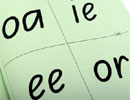 Teacher
Guide to Phonics and Phonics Activities
Teacher
Guide to Phonics and Phonics Activities
Many believe that without phonics we would never learn how to spell or read.
Phonics is a teaching method for learning how to spell and say words using sounds and patterns. When you see the letter 'C' and know that it makes a 'k' sound like in the word cat that is using phonics. Just the fact that you can read this article right now means you have experience with phonics, and it will help you when you start to learn much bigger words like 'catastrophe'.
How did you learn this? You might remember being in kindergarten or maybe even younger with a teacher or parent. Remember learning how to spell your name or you first words? Maybe not, but it is likely you used some form of phonics to do this.
Whole language is another strategy that can be implemented to help. Many people are have difficulty understanding the difference in philosophy between Phonics and Whole Language. We wrote a comparison between Phonics and Whole Language to help you better understand the differences. As our article points out, using the strengths of both philosophies can greatly benefit young readers.
English is the most widely known language, and comes from a background of five different ancient languages: Old English, Old Norse, Norman, Classical Latin and Greek. Your ancestors blended these languages together into the English you speak today. The 26 letters in the alphabet all represent the different sounds in our language and by using phonics we learn how to blend and say these sounds together so that we can understand one another. Those sounds are called phonemes, and each letter represents a phoneme. So when you say the word, "cat" the letter "C", the letter "A" and the letter "T" are all different sounds and phonemes.
That's the main meaning behind phonics. As you got older and learned new words you learn new areas of phonics such as how to blend to letters together to make one sound like "ch" in the word chair. This is actually called a digraph and includes such letter combinations as "th" and "ng" with consonants, or "ai" and "oo" with vowels.
Vowels are another really important part of learning phonics. Vowels are made up of A, E, I, O, U and sometimes Y. They help words sound better; otherwise a word like vowel would just be spelled "vwl". In phonics we learn that vowels have either short sounds like the U in cup, or the A in bat and are called short vowels. Long vowels are present in words like the A in baby or the O in throw.
And then there are even more types of vowel sounds that you use every day. When you start mixing vowels and consonants together to make bigger words you come across things such as having an E on the end of the word. This makes the other vowel a long vowel, like in the word base. If you didn't have the E on the end of that word it would sound like bass, which has a completely different meaning.
Do you ever notice that words with the letter R would sound much different if they didn't have that important letter? That's because the letter R changes the way we say vowels in words. Take the word surf, which sounds like "serf", but if you didn't have that R the letter U is said different, "suf", a short vowel sound.
Another common thing to come across in phonics goes by the funny name of diphthong. A diphthong happens in words like boil where you're actually pronouncing both the vowel sounds of O and I separately instead of blending them together like in a digraph. In the case of boil, the O is a long vowel and the I is a short one.
There are many forms of phonics you will come across as you come to grasp the English vocabulary. Many older people still come across new words that they have to learn to sound out to say right, and the phonics they learned at your age come in very handy!